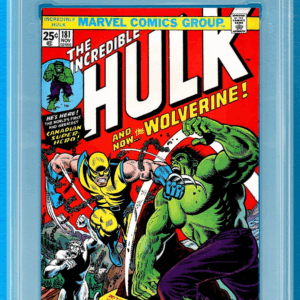In a move that could send ripples through the forest of comic book grading, PSA, the giant known for its unrivaled authority in grading sports and trading cards, is now extending its ink-stained fingers into the world of comic books and magazines. With an announcement that has electrified collectors, PSA has unveiled its official pricing and turnaround time structures, sparking a flurry of excitement and speculation about the implications for the comic book grading market, long held tightly by CGC.
Starting July 14, collectors will have a new player to consider. PSA’s foray is characterized by its modern-era approach—books from 1975 onwards can be graded starting at $25.99 per item, with an enticing 20-business-day turnaround promise. But PSA isn’t stopping at just grading; it’s offering a pressing service for those comics and magazines yearning for a touch-up, starting at a wallet-friendly $11.99. However, for collectors who opt for both grading and pressing, a test of patience is advised, as the entry-level processing time is expected to crank up to twice as long.
The comic book landscape has been a quiet dominion under the CGC banner, with all of the top 10 most expensive comics in history wearing the CGC seal of approval. PSA entering this domain represents a seismic shift that could disrupt CGC’s long-standing supremacy. It’s almost like Spider-Man swinging into the Batcave—unexpected, strategic, and with the potential for some exhilarating outcomes.
With their pricing structure, PSA seems to be wielding a sharp scalpel, aimed at carving out a niche within CGC’s territory. The grades they offer, often on par with, if not slightly more competitive than, CGC’s own, signal PSA’s laser-focused intent on attracting collectors: “Come hither,” they seem to say, “and taste the new gold standard.”
This isn’t PSA’s first rodeo in the comic book cosmos. Last year’s San Diego Comic-Con saw the clandestine unveiling of prototype holders, part of a glitzy collaboration with Marvel and the swanky fashion brand, Kith. Not just a sidebar in the world of pop culture, PSA put its stamp on this venture by encapsulating exclusive comic variants that accompanied the limited-edition “Marvel Super Villains” sneakers. One such variant—a tantalizing 1-of-1 Venom-Spider-Man sketch—etched its way into legend after selling for a jaw-dropping $30,000 on eBay. Such moves have kept PSA on the radar of both collectors and speculators, hinting at a broader master plan now coming to fruition.
Now, as July 14 looms, the question on every collector’s lips is: How will the hobby respond to PSA’s audacious entry into the comic book grading gauntlet? PSA has the clout, the infrastructure, and frankly, the muscle to make this work. While CGC has been the go-to name for decades, PSA’s entry could herald a new era—one of competition, innovation, and possibly, even better services for collectors.
But why exactly is this a big deal for the everyday comic book collector? The arrival of PSA introduces not just another option, but a new standard. With PSA’s storied reputation for rigidity and consistency in grading, collectors now have a competitive landscape to explore. This could lead to faster turnarounds, more accessible pricing, and possibly a greater alignment between the grading standards and the wibbly-wobbly, slightly mercurial expectations of the comic book market.
Moreover, the announcement couldn’t have come at a more tantalizing time. The comic book industry is experiencing something of a renaissance, with cinematic universes drawing in new fans and fetching record prices at auctions. The allure of a new player, especially one with a storied name like PSA, injects a shot of racecar-grade adrenaline into the mix.
PSA’s bold move opens up an assortment of possibilities for collectors and vendors alike—more competitive pricing, potentially lower submission fees, and a faster, more efficient grading process. It’s a change that could very well push the entire industry towards a new benchmark of excellence, with all parties benefiting from a duel between giants.
Collectors, dealers, and fanatics are holding their breath. Will PSA’s infiltration of the comic book world be like the introduction of a new superhero to save the day, offer fresh perspectives, and usher in an era of comic-book peace? Or will the saga play out like a classic comic book standoff, with CGC and PSA locked in a perpetual tug-of-war for the hearts—and wallets—of collectors worldwide? This battle of the giants is only just beginning.






